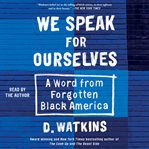Review by Choice Review
Finney (environmental science, policy, and management, Univ. of California, Berkeley) draws on a multitude of primary and secondary sources to address the interconnections between African Americans and the environment. Using a framework rooted in environmental history, critical race theory, cultural studies, and feminist geography, she illuminates how "race matters" in the ways the environment and environmental concerns have been conceptualized. As she demonstrates, cultural representation and racialization have led to a narrowing of environmentalism and a fundamental misreading of African Americans' relationship to nature throughout history. This history is replete with examples of a racial regime that denied or limited African Americans access to nature, along with stories of resistance and reclamation of such spaces. For example, the conspicuous absence of African Americans from depictions of the outdoors in popular media, particularly outdoor magazines, seems to confirm a supposed disinterest in the environment. Many environmental organizations and environmental leaders have yet to address questions of diversity proactively, often limiting the conversation to the subject of environmental justice. Finney's exemplary work moves beyond a critique of the movement and popular culture. It carves through multiple layers of meaning to excavate unique moments of African American environmental history that demand retelling. Summing Up: Highly recommended. All readers. --Carl M. Hand, Valdosta State University
Copyright American Library Association, used with permission.
Review by Library Journal Review
In six well-crafted chapters, with extensive endnotes, Finney (Univ. of California at Berkeley) presents the myriad circumstances inhibiting many African Americans' engagement with the natural world and pursuant environmental movements. By examining the complexities from historic, societal, and personal perspectives, the author illuminates the causes and nature of barriers to this community's environmental engagement. The text begins with a look into land access granted to specific groups of immigrants as juxtaposed against the experience of freed slaves, then travels through history to the formation of an environmental movement during a time when African Americans were denied basic human rights of property and person. Also, while the Wilderness and the Civil Rights Acts were both passed in 1964, the former failed to consider the cultural implications of the latter. Through additionally analyzing the theoretical constructs of signifiers that grant Americans "place" in the natural environment, Finney makes a clear case for the dominant culture's habitual (though, sometimes unwitting) rejection of African Americans. This is reinforced by sound research with both objects (national publications) and subjects (human participants). Finney's discussion includes sensitive treatment of questions of "authenticity" within the African American community and how environmental, or nature-based behaviors do or do not fit in with these mores. The book ends on a somewhat more positive note, suggesting that since the author's research began nearly ten years ago, the movement to allow room for all citizens at spaces of natural splendor is beginning to take root. VERDICT Highly recommended: for those interested in environmental studies, interdisciplinary studies, and civil rights.-Jewell Anderson, Savannah Country Day Sch. Lib., GA (c) Copyright 2014. Library Journals LLC, a wholly owned subsidiary of Media Source, Inc. No redistribution permitted.
(c) Copyright Library Journals LLC, a wholly owned subsidiary of Media Source, Inc. No redistribution permitted.

